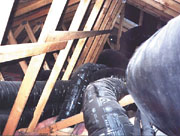Or, more precisely, you could say it does research on the movement of air and associated penalties involving distribution of fresh air, energy, and pollutants.
For the full story, Max Sherman, senior scientist and group leader, described some of the projects his staff is involved in.
One project is the Building America program. One of the team leaders is Building Science Corp., Westford, MA, and this firm works with a number of residential builders with the goal of “making new production houses 30% more efficient than the model energy code,” said Sherman.
Building Science provides technical assistance to the builders in upgrading their design. There are a couple of different design approaches depending on style and climate, he noted. One that works in the Sun Belt is called the unvented attic design.
Explained Sherman, “That’s where they move the insulation from the attic floor up to the rafters and seal the attic so that it essentially becomes part of the conditioned space.” With this method, thermal distribution losses are greatly reduced, he said.
This is one of the areas where LBNL has gotten involved, testing and measuring houses in Las Vegas, NV, to see how efficient they are. The lab basically provides third-party evaluation to show that the components perform as they should.

Let’s Vent
Also part of the Building America program is mechanical ventilation because the houses are tightly constructed and need proper ventilation. LBNL assists here in sizing.Ventilation strategies employed include using a continuously operating mechanical exhaust fan.
“Another is to put an air inlet into the return duct of the air handler so that you have outside air coming in,” said Sherman. Then a recycler is installed, “which makes sure that, if the air handler hasn’t run for a couple of hours, it will run it just to make sure there’s enough ventilation,” he related.
“These houses also use some innovative framing methods,” said Sherman, “where they use less wood and get more space for insulation, and at the same time improve seismic resistance, which is important out here in California.”
The Building America homes are redesigned so that they essentially don’t cost any more than typical homes; they are just much more energy efficient. By reducing the load, smaller air conditioning systems and smaller air handlers can be used to help pay for the design improvements.
Another project that LBNL is carrying out now is collecting and analyzing leakage data. Its staff is gathering building envelope and duct leakage data for inclusion in its Residential Diagnostics Database. Data has been collected for the past year, coming in from various people and groups. About 80,000 measurements have been accumulated.
Sherman said his group will do a preliminary analysis and have a report out this fall. But this data won’t be statistically representative of the entire country. So, over the next year, it will be combined with other available data so that it will be “meaningful on a nationwide basis.”
The LBNL collected leakage data about 10 years ago and that data showed U.S. homes were very leaky, he remarked. The new report will indicate air tightness and efficiency today.
For the California Institute for Energy Efficiency (CIEE), LBNL is now in the final stages of a project looking at thermal distribution and air conditioning issues. One of the things being developed is a new method for measuring the leakage of duct systems. Researchers are taking measurements of existing houses in California to examine duct efficiency and how flex duct ages.
The lab is also doing modeling on right-sizing. A lot of air conditioners in the Sun Belt are oversized, he stated. With tighter homes, oversized units are very inefficient and they don’t do as good a job of dehumidifying. So right-sizing is being studied to provide strategies to make sure that comfort is still supplied.
Sherman believes that hvac contractors are a bit reluctant regarding right-sizing because they don’t want callbacks. “They really have to be convinced that it’s going to work. They need good demonstrations.” That’s part of what Building Science does, he said, showing that houses with down-sized units do, in fact, provide good comfort and that this reduces the chance of callbacks, rather than increases it.

Plugging the Leaks
LBNL has also recently developed and patented a new duct sealing technology. A lab member who was an inventor of the process formed a company, called Aeroseal, that has licensed the technology in order to commercialize it.The aerosol-based duct sealing system blows aerosolized adhesive particles into the ducts and deposits them at the leakage sites, sealing the leaks without leaving deposits on duct surfaces. The LBNL reports that sealing duct leaks reduces heating and cooling energy use by up to 30%. Sherman noted that the lab’s research work shows that this method is effective and cost efficient. (More information can be found at www.aeroseal.com.)
Infiltration is another problem that affects virtually all size buildings, residential and commercial.
“Sometimes it’s an energy issue. Sometimes it’s a comfort issue. Sometimes it’s a durability issue,” he said. In the residential sector, LBNL determined that 1 to 2 quads of energy are lost through infiltration.
Regarding Sick Building Syndrome, ventilation is definitely one component, said Sherman. “But Sick Building Syndrome often has a lot to do with microbiological molds and fungus.”
He believes that mold problems have been in the news more lately both because we’re “more aware of it and more sensitized to the issue,” but also because there are certain building styles used in the last few years, such as exterior insulating systems, that lend themselves to moisture problems, which can lead to mold.
And, as a resident of California, LBNL has been working with the state on its energy crisis. The concentration to date has been on short-term measures, Sherman commented, with the lab advising the state on “what can be put in place the day after tomorrow.” He anticipates a more long-term view after the summer crunch.
Publication date: 07/30/2001


Report Abusive Comment